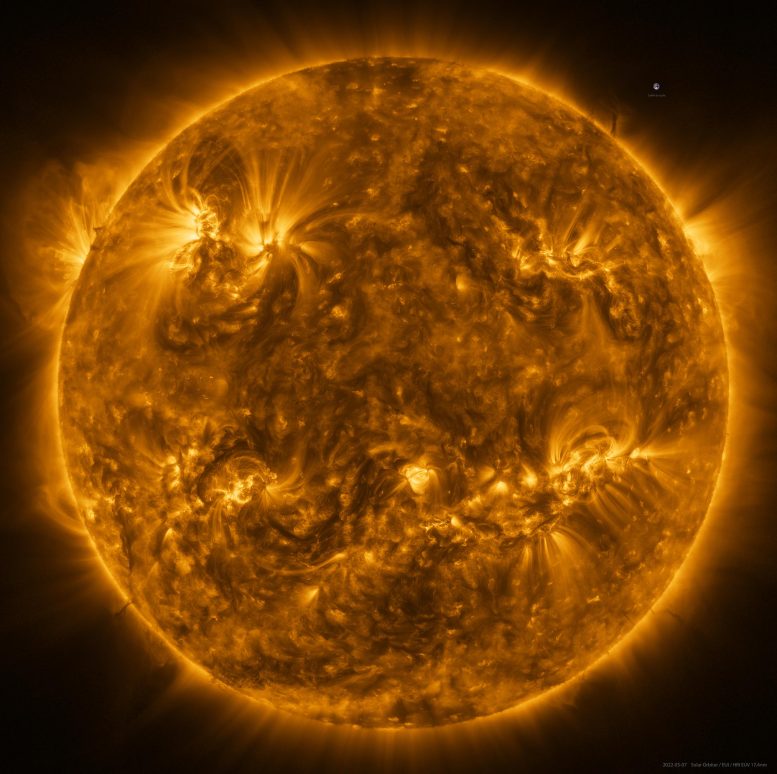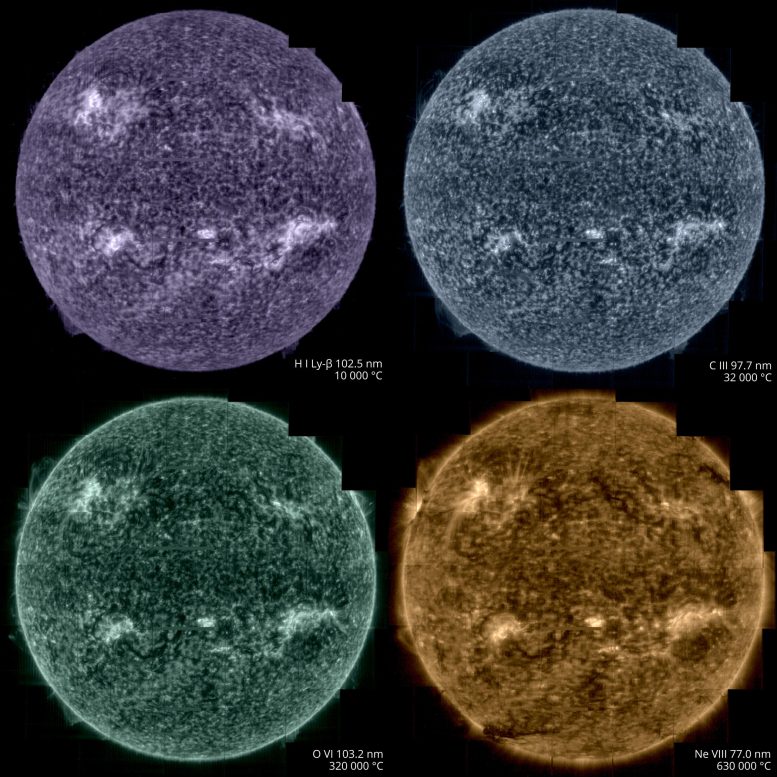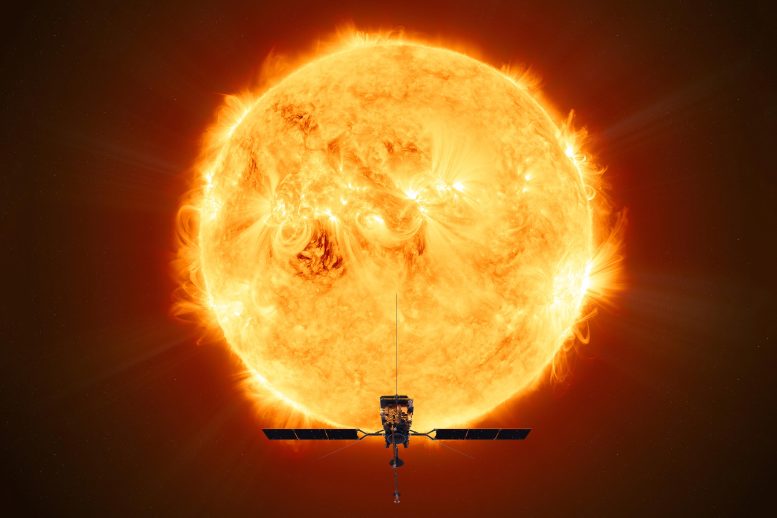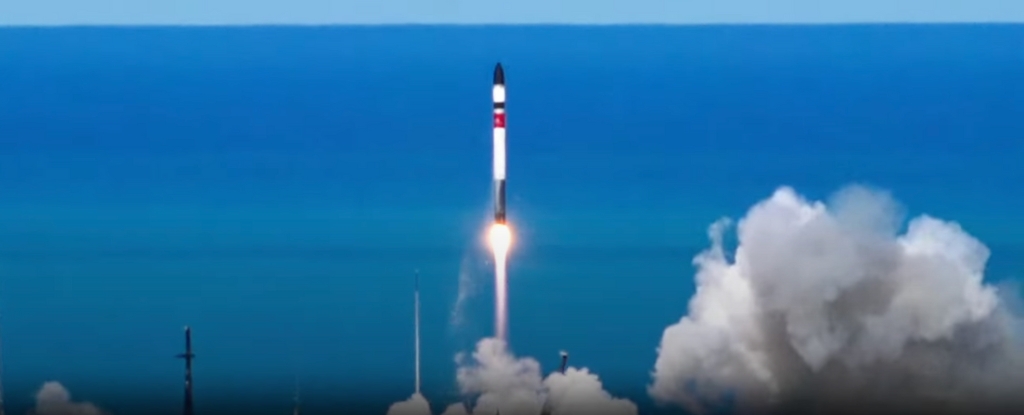
Animáció az Európai Űrügynökség Solar Orbiter-járól. Köszönet: ESA / Medialab
A Solar Orbiter legfrissebb képei példátlan részletességgel mutatják be a teljes napot. 2022. március 7-én készült, amikor az űrszonda közvetlenül a Föld és a Nap között haladt.
Az Extreme Ultraviolet Imager (EUI) által rögzített egyik kép a teljes napkorongról és a külső légkörről, a koronáról készült valaha készült legnagyobb felbontású kép.
Egy másik kép, amelyet a Spectral Imaging of the Coronal Environment (SPICE) műszer készített, 50 év óta az első teljes napképet képviseli, és a legjobb felvételt a hidrogéngáz által kibocsátott ultraibolya sugárzás Lyman béta hullámhossza mentén.
A képek akkor készültek, amikor a szoláris keringő körülbelül 75 millió kilométerre volt, félúton világunk és szülőcsillaga között. Az EUI nagyfelbontású teleszkópja olyan nagy térbeli felbontású képeket készít, hogy ilyen közeli távolságban egy 25 képből álló mozaik szükséges ahhoz, hogy a teljes Napot lefedje. Egyenként készítve a teljes kép több mint négy órán keresztül készült, mert minden darab körülbelül 10 percet vesz igénybe, beleértve azt az időt is, amely alatt az űrszonda az egyik részről a másikra mutat.

A Nap a Solar Orbiter által extrém ultraibolya fényben, körülbelül 75 millió km távolságból. A kép 25 különálló képből álló mozaik, amelyet 2022. március 7-én készített az Ultraviolet Imaging Instrument (EUI) nagyfelbontású teleszkópja. Ez a kép 17 nanométeres hullámhosszon, az elektromágneses spektrum extrém ultraibolya tartományában készült, feltárva a Nap felső légkörét, a koronát, amelynek hőmérséklete körülbelül egymillió Celsius fok. A 2 órai pozícióban lévő skála Földről készült képe is mellékelve.. Köszönetnyilvánítás: ESA és NASA/Solar Orbiter/EUI Team; Adatfeldolgozás: E. Kraaikamp (ROB)
Összességében a végső kép Több mint 83 millió pixelt tartalmaz egy 9148 x 9112 pixeles rácsban. Összehasonlításképpen: ennek a képnek tízszer jobb a felbontása, mint amit egy 4K tévéképernyő képes megjeleníteni.
Az EUI a Napot 17 nanométeres hullámhosszon ábrázolja, az elektromágneses spektrum extrém ultraibolya tartományában. Ez feltárja a Nap felső légkörét, a koronát, amelynek hőmérséklete körülbelül egymillió fok[{” attribute=””>Celsius.

Solar Orbiter took images of the Sun on March 7, from a distance of roughly 75 million kilometres, using its Spectral Imaging of the Coronal Environment (SPICE) instrument. SPICE takes simultaneous “spectral images” at several different wavelengths of the extreme ultraviolet spectrum by scanning its spectrometer slit across a region on the Sun. The different wavelengths recorded correspond to different layers in the Sun’s lower atmosphere. Purple corresponds to hydrogen gas at a temperature of 10,000°C, blue to carbon at 32,000°C, green to oxygen at 320,000°C, yellow to neon at 630,000°C. Each full-Sun image is made up of a mosaic of 25 individual scans. It represents the best full Sun image taken at the Lyman beta wavelength of ultraviolet light that is emitted by hydrogen gas. Credit: ESA & NASA/Solar Orbiter/SPICE team; Data processing: G. Pelouze (IAS)
At the 2 o’clock (near the image of the Earth for scale) and 8 o’clock positions on the edges of the Sun, dark filaments can be seen projecting away from the surface. These ‘prominences’ are prone to erupt, throwing huge quantities of coronal gas into space and creating ‘space weather’ storms.
In addition to EUI, the SPICE instrument was also recording data during the crossing. These too needed to be pieced together as a mosaic.
SPICE is designed to trace the layers in the Sun’s atmosphere from the corona, down to a layer known as the chromosphere, getting closer to the surface. The instrument does this by looking at the different wavelengths of extreme ultraviolet light that come from different atoms.

Taking the Sun’s temperature. Credit: ESA & NASA/Solar Orbiter/SPICE team; Data processing: G. Pelouze (IAS)
In the SPICE sequence of images purple corresponds to hydrogen gas at a temperature of 10,000°C, blue to carbon at 32,000°C, green to oxygen at 320,000°C, yellow to neon at 630,000°C.
This will allow solar physicists to trace the extraordinarily powerful eruptions that take place in the corona down through the lower atmospheric layers. It will also allow them to study one of the most puzzling observations about the Sun: how the temperature is rising through the ascending atmospheric layers.
Usually the temperature drops as you move away from a hot object. But above the Sun, the corona reaches a million degrees Celsius whereas the surface is only about 5000°C. Investigating this mystery is one of the key scientific objectives of Solar Orbiter.
The images were taken on 7 March, precisely when Solar Orbiter crossed the Sun-Earth line, so the images can be compared with Earth-bound solar instruments and cross-calibrated. This will make it easier to compare results from different instruments and observatories in future.
On March 26, Solar Orbiter reaches another mission milestone: its first close perihelion. The spacecraft is now inside the orbit of Mercury, the inner planet, taking the highest resolution images of the Sun it can take. It is also recording data on the solar wind of particles that flows outwards from the Sun.
And this is just the start, over the coming years the spacecraft will repeatedly fly this close to the Sun. It will also gradually raise its orientation to view the Sun’s previously unobserved polar regions.
Solar Orbiter is a space mission of international collaboration between ESA and NASA.

„Utazási specialista. Tipikus közösségi média tudós. Az állatok barátja mindenhol. Szabadúszó zombinindzsa. Twitter-barát.”






More Stories
A NASA fejlett napvitorláját sikeresen telepítették az űrbe: ScienceAlert
A NASA űrhajósai, Butch Wilmore és Sonny Williams a Boeing első emberes űrrepülésével Floridába érkeznek.
Hogyan készülnek a tudósok Apophis riasztó közeledésére a Föld felé?